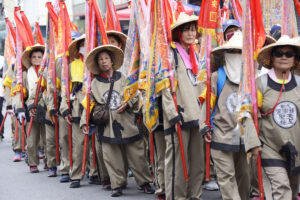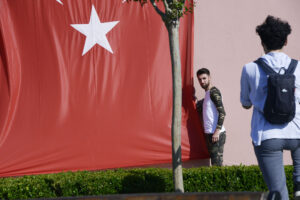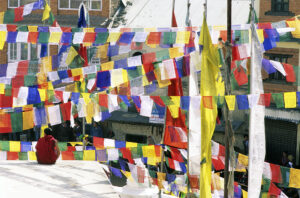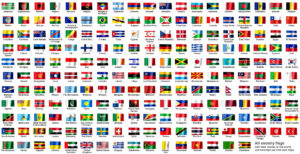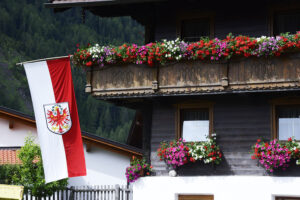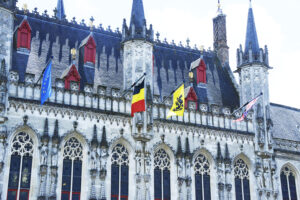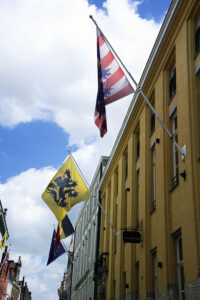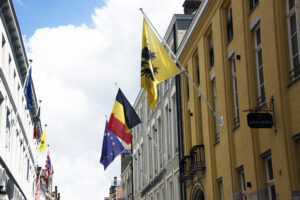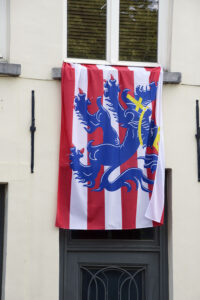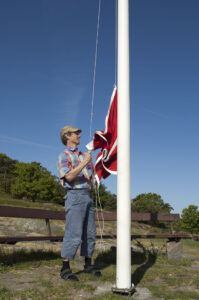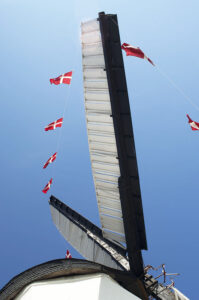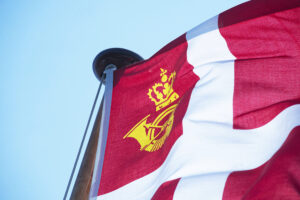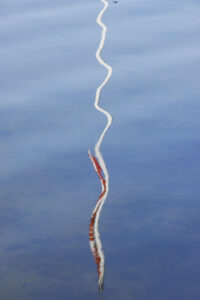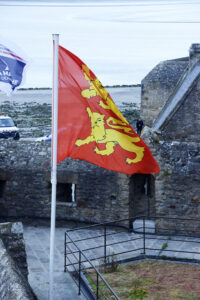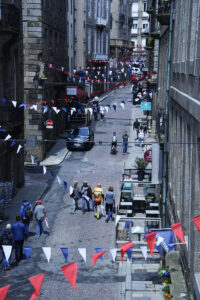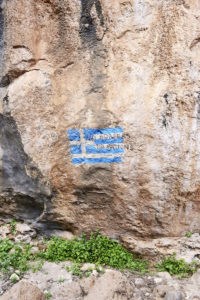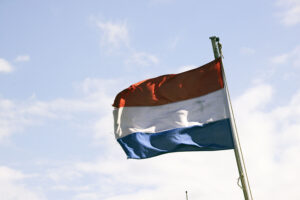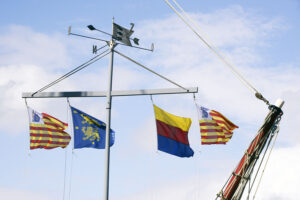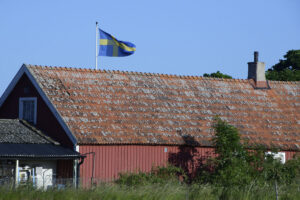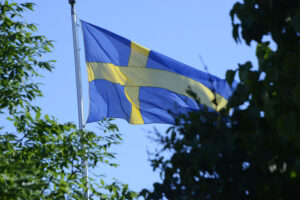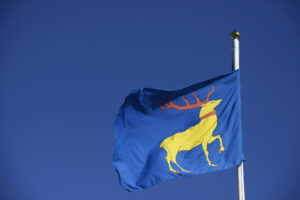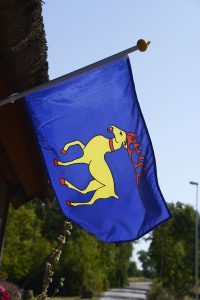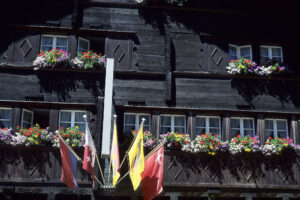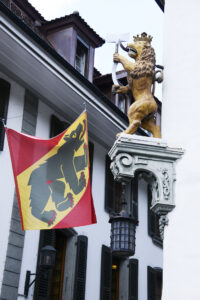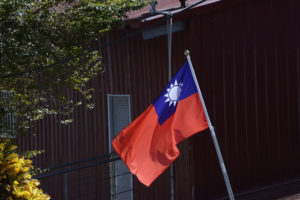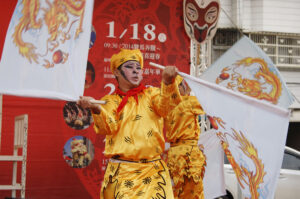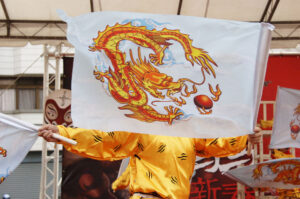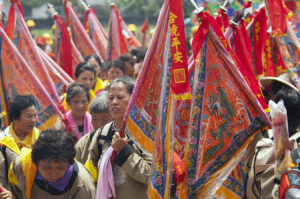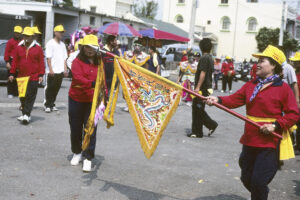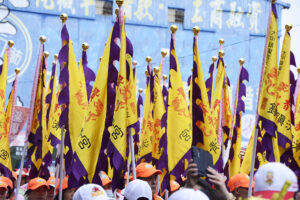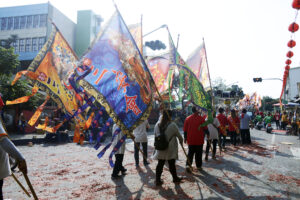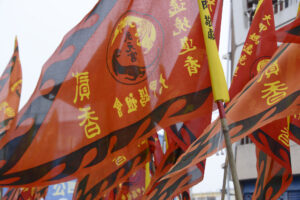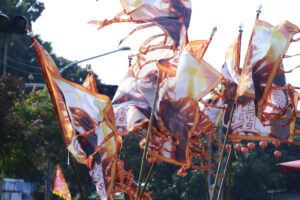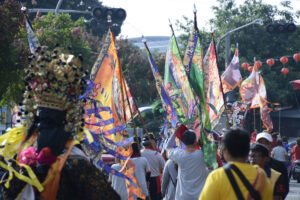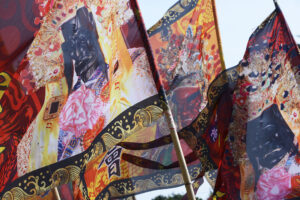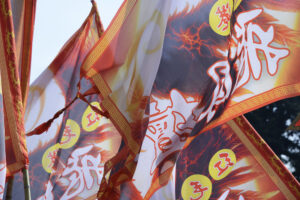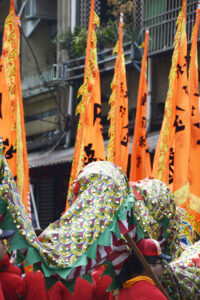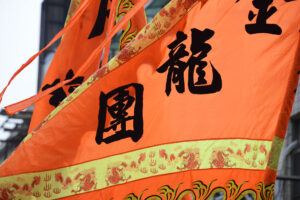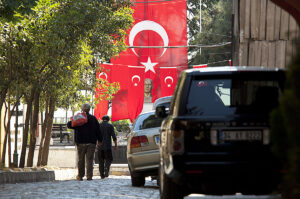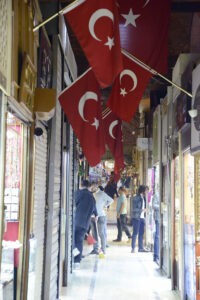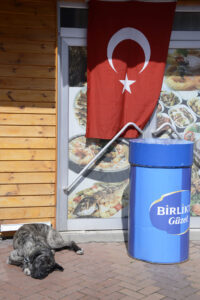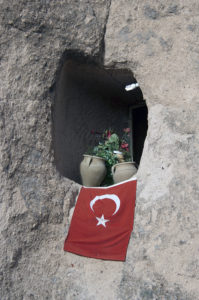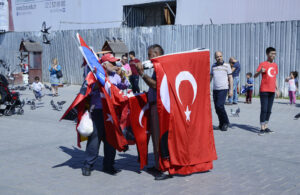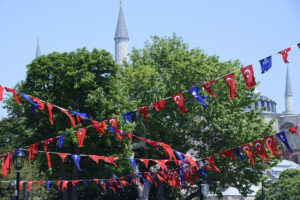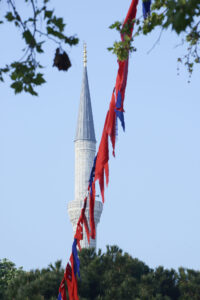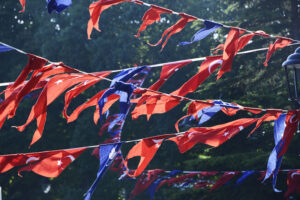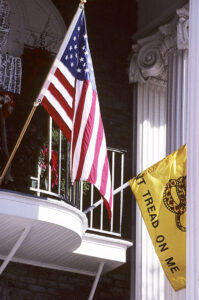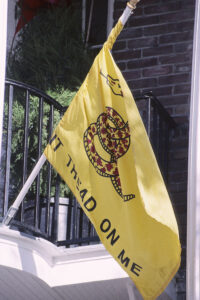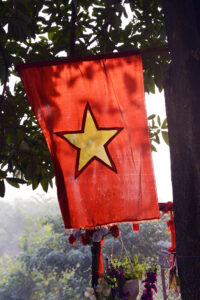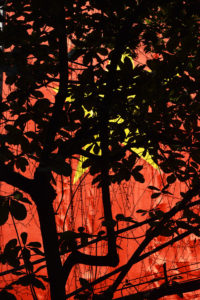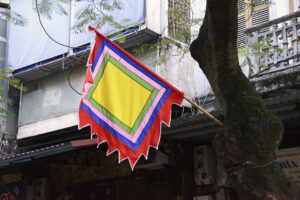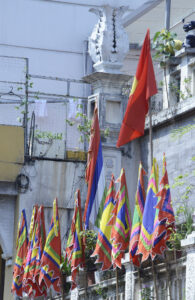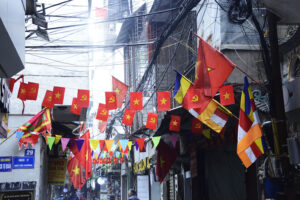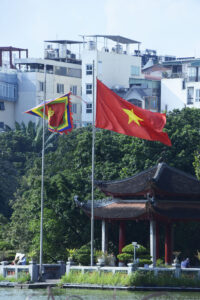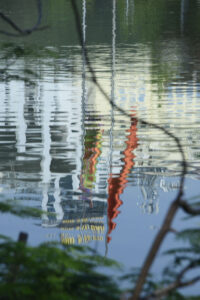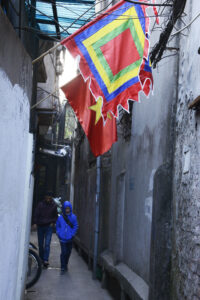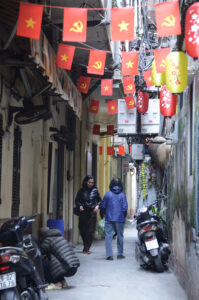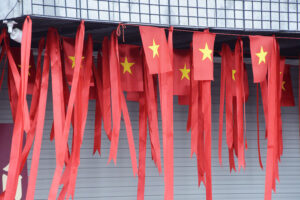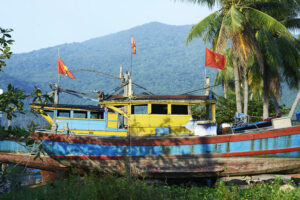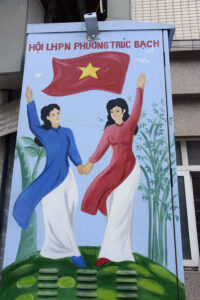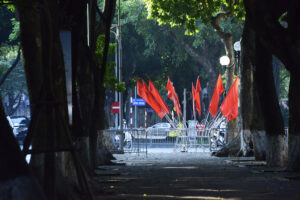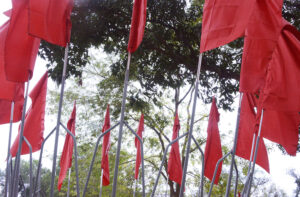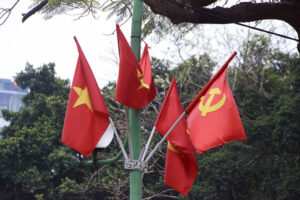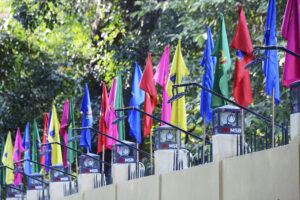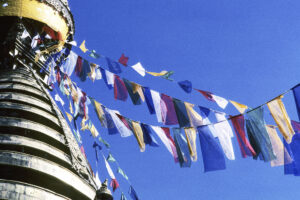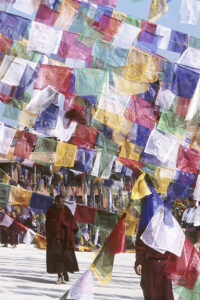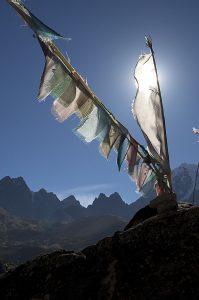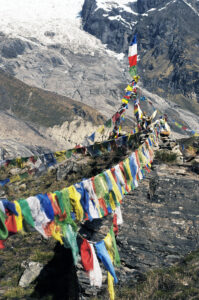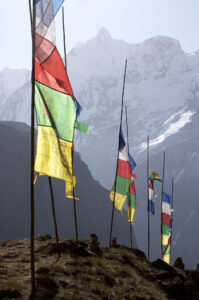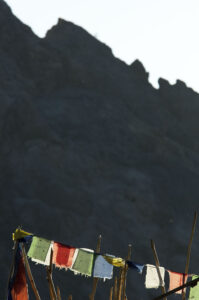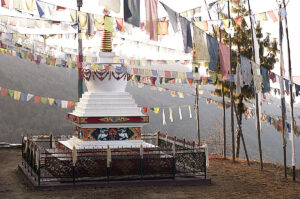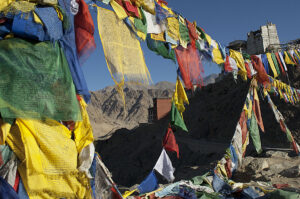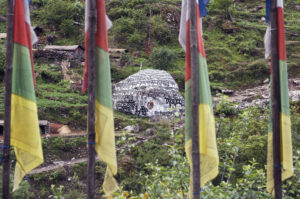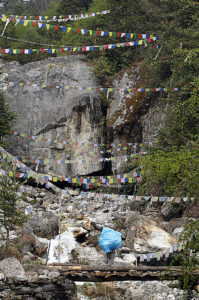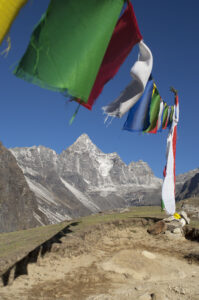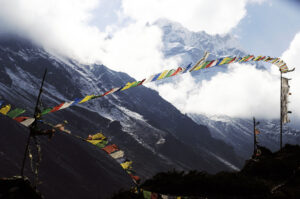Flags and banners
During the annual Daoist Mazu Festival in Taiwan, these pilgrims are participating in an 8-day-long march from temple to temple, carrying banners. (Photo copyright © by Kaj Halberg)
Many Turks are very proud of their country. This man wants to be photographed beside an immense Turkish flag, Istanbul. (Photo copyright © by Kaj Halberg)
During Losar, the Tibetan New Year, the Bodhnath Stupa in Kathmandu, Nepal, is decorated with countless prayer flags. (Photos copyright © by Kaj Halberg)
National flags are usually rectangular, with a few exceptions (Nepal, Switzerland, and the Vatican State).
National flags of all countries. (Borrowed from allwavingflags.com)
A banner can be a flag or another piece of cloth bearing a symbol, logo, slogan or another message. A flag whose design is the same as the shield in a coat of arms is called a banner of arms.
A pennant is a flag or a banner that is longer than broad, gradually tapering to a point.
Austria
The local banner of Tyrol, a Bundesland (federal state) in western Austria, has a white and a red bar, and in the centre a coat of arms with a red eagle on a white background. This banner has been in use since the early 19th Century.
The banner of Tyrol and scented geraniums (Pelargonium), Virgental, Tyrol. (Photo copyright © by Kaj Halberg)
Belgium
The national flag of Belgium, which has 3 vertical bands, black, yellow, and red, was instigated in 1831. The black and yellow colours were taken from the coat of arms of the Duchy of Brabant, a state of the Holy Roman Empire, which was established in 1183 and included parts of present-day Belgium and Holland.
The pictures below show flags in the city of Brugge, in the upper picture displayed on the town hall, from left the flag of the European Union, then the national flag, 3rd the flag of Flanders, the northern Flemish-speaking part of Belgium, yellow with a black lion, and finally the local flag of Brugge, with red and white stripes and a blue lion with a yellow crown, a necklace with a small yellow cross, and red claws. Similar flags were seen in a nearby street.
(Photos copyright © by Kaj Halberg)
The local flag of Brugge. (Photo copyright © by Kaj Halberg)
Cambodia
The Cambodian national flag has three horizontal bands, two narrower in blue and a broader one in red, which has a depiction of the famous temple complex Angkor Wat. This flag was officially adopted in 1993 as the national flag.
The national flag of Cambodia, Siem Reap. (Photo copyright © by Kaj Halberg)
Denmark
The national flag of Denmark, called Dannebrog, is red with a white cross that extends to the edges of the flag. It holds the world record of being the oldest continuously used national flag.
An old legend relates that this flag fell from the sky in 1219 during the Battle of Lyndanise in Estonia, when the Danish King Valdemar II (1170-1241), called Valdemar the Victorious, together with his Christian German allies, fought against pagan Estonian tribes. The crusading army camped at Lyndanise and built a castle there, named Castrum Danorum, by the Estonians called Taani-linn (‘Danish town’), later abbreviated to Tallinn.
On June 15th, the Estonians attacked the Danes near the castle, advancing from five different directions. The Danish crusaders were completely surprised by the attack and were only saved by a counterattack from their Wendish vassals. Tradition has it that when the Danes were in dire need, Dannebrog fell from the sky and gave them renewed hope.
However, two Danish Middle Age historians, Christiern Pedersen (c. 1480-1554) and Peder Olsen (died 1570), both mention, independently, that Dannebrog fell from the sky during another battle in Estonia, at Fellin, Sakala, in 1208 – a battle of much less importance than the battle at Lyndanise.
Hoisting the Danish flag on a hill at the outskirts of Gudhjem, Bornholm. (Photo copyright © by Kaj Halberg)
Årsdale Mølle is an old Dutch type windmill on Bornholm. On the day, when this picture was taken, the mill was put into work for the benefit of tourists, and strings had been tied to the wings, decorated with tiny Danish flags. Årsdale Mølle is described in depth on the page Culture: Mills. (Photo copyright © by Kaj Halberg)
This type of Dannebrog, observed on the ferry between the town of Gudhjem, Bornholm, and the islet of Christiansø, is a postal flag, with a depiction of the Danish royal crown and a post horn in the upper inner square. It denotes that this ferry carries mail to the inhabitants of Christiansø. (Photo copyright © by Kaj Halberg)
Pennant, reflected in water, northern Zealand. (Photo copyright © by Kaj Halberg)
France
The local flag of Normandy, depicting two yellow lions on a red background, Mont St. Michel, Brittany. (Photo copyright © by Kaj Halberg)
Pennants above a street, St. Malo, Brittany. (Photo copyright © by Kaj Halberg)
Greece
The national flag of Greece has 9 horizontal stripes, 5 blue and 4 white. These stripes have no specific meaning, but a popular interpretation is that they represent the 9 letters of the word ελευθερία (‘freedom’). The white cross in the upper left corner symbolizes the official religion of the country, the Eastern Orthodox Christianity.
In this picture, the Greek flag has been painted on a rock wall in a gorge near Sougia, Crete. Maybe the person was short of paint, since the flag has only 7 stripes instead of 9. Somebody, who is less nationalistic, has written on the flag: ‘No borders, no nations’. (Photo copyright © by Kaj Halberg)
Holland
The national flag of Holland has 3 horizontal bands, red, white, and blue. It is a variant of the late 16th Century Prinsenvlag (‘Prince’s Flag’), which was orange, white, and blue.
The Dutch national flag, observed in the city of Enkhuizen. (Photo copyright © by Kaj Halberg)
The picture below shows flags on an old Dutch sailing ship in Enkhuizen, from left the coat of arms flag of Enkhuizen, which has 13 alternating red and yellow stripes, in the upper left corner a maiden, holding a board depicting 3 fish, 3 golden crowns, and 3 golden stars; 2nd the flag of West Friesland with two golden lions and 5 golden rectangles on a blue background; 3rd the yellow, red and blue flag of the province of North Holland; and finally again the flag of Enkhuizen.
(Photo copyright © by Kaj Halberg)
Sweden
The origin of the national flag of Sweden can be traced back to the mid-1500s. It is blue with a yellow cross, probably inspired by Dannebrog, the Danish flag (se above). The colours stem from the coat of arms of Sweden, which shows two golden lions, holding a shield, which is divided into 4 parts, two with golden lions on a blue and white background, and two with 3 golden crowns on a blue background.
The national flag of Sweden, observed on the island of Öland. (Photos copyright © by Kaj Halberg)
The Swedish pennant is divided into two equal parts, a blue and a yellow. – Öland. (Photo copyright © by Kaj Halberg)
The theme on the local banner of Öland is identical to the official heraldic coat of arms of the island, dating back to c. 1560: a blue sheet of bunting, depicting a golden stag with red antlers, tongue, and hooves, and wearing a red collar – a symbol of Öland as a royal hunting area. (Photo copyright © by Kaj Halberg)
This Öland banner was fluttering in the wind outside a farm in the village of Gillsätra. (Photo copyright © by Kaj Halberg)
Switzerland
Hotel with various kanton flags, Wassen, Reuss Valley, Kanton Uri. (Photo copyright © by Kaj Halberg)
This picture from the city of Thun shows the kanton flag of Berner Oberland, and a heraldic lion, armed with an axe. (Photo copyright © by Kaj Halberg)
Taiwan
The national flag of Taiwan, or, as the country is officially named, the Republic of China, is described as depicting ‘a blue sky, a white sun, and a wholly red earth’.
Any sane Taiwanese calls his or her country Taiwan, so why keep the old name, which was imposed on the country by Chinese invaders?
(Photo copyright © by Kaj Halberg)
Acrobats, dressed as monkeys, perform with banners, Taichung. (Photos copyright © by Kaj Halberg)
In Taiwan, the prevailing religion is a unique blend of Buddhism and Daoism, characterized by numerous gods and numerous festivals. Colourful banners are always an important issue during these festivals, as seen from the collection of pictures below.
(Photos copyright © by Kaj Halberg)
Turkey
The national flag of Turkey is red with a white crescent and a white star. It is identical to the flag of the Ottoman Empire, which was adopted in the late 18th Century and acquired its final form in 1844.
In this picture, a bust of Mustafa Kemal Atatürk, birth name Ali Rıza oğlu Mustafa (1881-1938), can just be glimpsed behind a collection of Turkish flags, stretched across a street in Istanbul. He founded the Republic of Turkey and was its first president 1923-1938. (Photo copyright © by Kaj Halberg)
Turkish flags in Kapalıçarşı (‘The Covered Market’), Istanbul. (Photo copyright © by Kaj Halberg)
Dog, sleeping beneath a Turkish flag, Amasra, Black Sea. (Photo copyright © by Kaj Halberg)
Turkish flag and flowers outside an inhabited cave, which has been carved out of eroded tuff rocks, Göreme. central Turkey. (Photo copyright © by Kaj Halberg)
Street vendors, selling flags, Istanbul. (Photo copyright © by Kaj Halberg)
Pennants, depicting the Turkish flag, alternating with the blue edition of the Istanbul Metropolitan Municipality flag, Istanbul. In the background a flowering horse-chestnut tree (Aesculus hippocastanum), and minarets of the Sultan Ahmed Camii (‘Sultan Ahmed Mosque’), better known as ‘The Blue Mosque’. (Photos copyright © by Kaj Halberg)
United States
The American flag, popularly called Stars and Stripes, has 13 horizontal stripes in red and white, representing the thirteen British colonies that declared independence from England in 1776 and formed the first states in the United States. The 50 stars represent the present 50 states in the union.
During the American Revolution, the banner used by the rebels depicts a coiled rattlesnake, and a text saying Don’t Tread on Me. The American Revolution is described in depth in a novel, written by my late friend John Burke, presented unabridged on this website on the page Novel: Rose of the Revolution.
These pictures from Charleston, South Carolina, show the American flag and the banner used by the rebels during the American Revolution. (Photos copyright © by Kaj Halberg)
Vietnam
The Vietnamese national flag is bright red with a large yellow star in the centre. It was created in 1955 and used during an uprising against the French rulers. The red colour symbolizes the blood that was shed during the uprising, whereas the star represents the five main classes in Vietnamese society: intellectuals, farmers, workers, business people, and soldiers.
Another Vietnamese flag, the so-called five-colour flag, consists of 5 concentric squares in red, green, yellow, and blue, and sometimes white. The order of the colours varies. The outermost square has 3 ragged edges. This flag represents the five elements (wood, metal, fire, water, and earth). It is traditionally flown during festivals and religious ceremonies.
The Vietnamese national flag, Hanoi. (Photo copyright © by Kaj Halberg)
In this picture, the Vietnamese flag is seen behind a tree in Hanoi. (Photo copyright © by Kaj Halberg)
The Vietnamese five-colour flag, symbolizing the five elements (wood, metal, fire, water, and earth), Hanoi. (Photo copyright © by Kaj Halberg)
The national flag and numerous five-colour flags, Hanoi. (Photo copyright © by Kaj Halberg)
Numerous flags, banners, and pennants above a street in Hanoi. The flags with hammer and sickle represent the Vietnamese Communist Party. (Photo copyright © by Kaj Halberg)
The national flag and a five-colour flag at the Ngoc Son Temple in Hoan Kiem Lake, Hanoi. In the lower picture, they are reflected in the lake. (Photos copyright © by Kaj Halberg)
The national flag and a five-colour flag in an alley in Hanoi. (Photo copyright © by Kaj Halberg)
Numerous flags and paper lanterns in another alley in Hanoi. The flags with hammer and sickle represent the Vietnamese Communist Party. (Photo copyright © by Kaj Halberg)
National flags and red ribbons, Hanoi. (Photo copyright © by Kaj Halberg)
This dilapidated boat in Da Nang has been adorned with national flags. (Photo copyright © by Kaj Halberg)
These women are exercizing in the morning, wearing T-shirts, depicting the Vietnamese flag, near Lake Truc Bach, Hanoi. (Photo copyright © by Kaj Halberg)
Here, the national flag is depicted on a scooter (top), and on an electricity meter box, Hanoi. (Photos copyright © by Kaj Halberg)
Flags on metal poles are ubiquitous in Hanoi. The flags with hammer and sickle represent the Vietnamese Communist Party. (Photos copyright © by Kaj Halberg)
Numerous flags, adorning a wall, Hanoi. (Photo copyright © by Kaj Halberg)
Prayer flags
In Tibetan Buddhism, prayer flags are coloured pieces of cloth, tied to strings or poles, and always arranged in this order: blue, white, red, green, and yellow. Buddhist mantras are printed on these flags, and when they flutter in the wind, the mantras are dispersed into space for the benefit of humankind.
Prayer flags are ubiquitous in areas, where the Tibetan Buddhism prevails, especially in Tibet, Ladakh, and the Himalaya.
Prayer flags adorn the Swayambhunath Stupa, Kathmandu, Nepal. (Photo copyright © by Kaj Halberg)
During Losar, the Tibetan New Year, the Bodhnath Stupa in Kathmandu is decorated with countless prayer flags. (Photo copyright © by Kaj Halberg)
Prayer flags, illuminated by the rising sun, Fanga, Gokyo Valley, Khumbu, eastern Nepal. (Photo copyright © by Kaj Halberg)
Prayer flags, Annapurna Base Camp, Annapurna Sanctuary, central Nepal. (Photos copyright © by Kaj Halberg)
Prayer flags, outlined against dark rocks, Ulley, Ladakh, India. (Photo copyright © by Kaj Halberg)
Morning sunshine illuminates a chorten (the Tibetan edition of a stupa) and countless prayer flags, Shermatang, Helambu, central Nepal. (Photo copyright © by Kaj Halberg)
Prayer flags, fluttering in the wind on a rocky ridge beneath King Tashi Namgyal’s old fort, built in the 1500s, near Leh, Ladakh. (Photo copyright © by Kaj Halberg)
Prayer flags in front of a mani stone (a stone with chiseled Buddhist mantras), Tharo Kosi, Khumbu, eastern Nepal. (Photo copyright © by Kaj Halberg)
Porter, crossing a log bridge across a tributary to the Ghunsa River, eastern Nepal. Numerous strings with prayer flags are spanning the valley. (Photo copyright © by Kaj Halberg)
Prayer flags in front of the mountain Dragkya (5657 m), Machhermo, Gokyo Valley, Khumbu, eastern Nepal. (Photo copyright © by Kaj Halberg)
Prayer flags, fluttering fiercely in a gust of wind, Kambachen, Upper Ghunsa Valley, eastern Nepal. (Photo copyright © by Kaj Halberg)
(Uploaded October 2023)
(Latest update February 2025)
